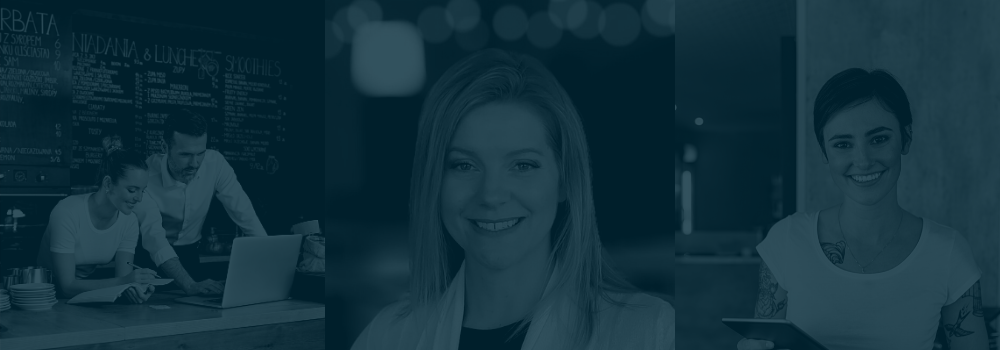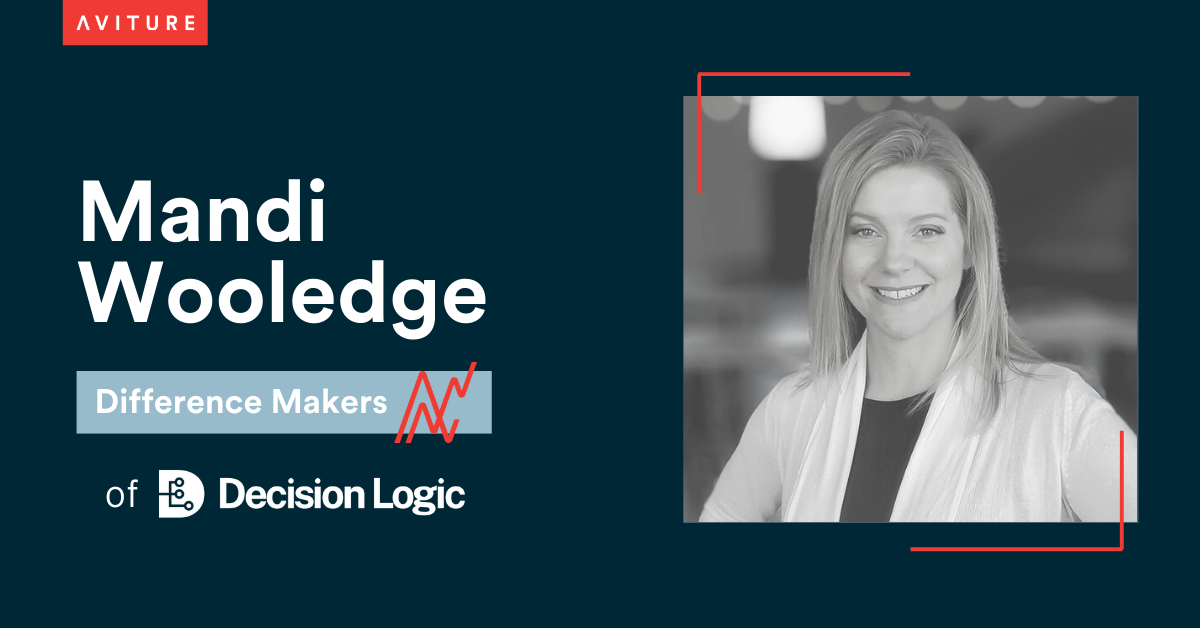Events | Decision Logic | webinar | Difference Makers | thought leadership
Welcome to Difference Makers, a webinar series spotlighting people and organizations driving a culture of innovation across the country.
In this webinar, Aviture’s own Steve Miller, Director of Government Solutions, chats with Mandi Wooledge, President and COO of Decision Logic about how her company saves restaurants time and thousands of dollars — allowing managers to focus on serving their customers.
Catch some of the highlights from our conversation with Mandi, or watch the full webinar, below.
Webinar Highlights
About Mandi
Steve Miller, Aviture:
So if you wouldn't mind kicking us off by just telling us a little bit of the background of yourself and the Decision Logic story?
Mandi Wooledge, Decision Logic:
Absolutely. My name is Mandi, I've been with the company for around 10 years, and prior to that I was a restaurant operator. I started off waiting tables in the restaurant business when I was 13 years old. It was the very first job I had, and I worked at this tiny little cafe in a small town we lived in.
When I first started, this cafe was so small we did everything. Washrf our own dishes, sometimes we flipped the pancakes, but it was all about making sure the guests in our town were guests inside this diner, which was named after someone's grandmother. It was their kitchen. Because of that, it was really like inviting somebody into your home and making sure you were taking care of them.
My late brother-in-law told me at the time that as long as I kept smiling and kept people's drinks full, I'd make a lot of money. And I took that to heart. At 13 years old, I could pull down 80 bucks on a Saturday. That was huge.
At that point, I really fell in love with the restaurant business, I fell in love with that hospitality, I fell in love with taking care of people and leaving things better than I found them. That was something that really resonated with me.
When I moved to Lincoln, Nebraska to go to school, I ended up waiting tables at another restaurant. My brother had already waited tables there before. I was really hesitant about going into the same spot that he was at because I didn't want to be "Adam's little sister," but I did really enjoy working with all the people who were there.
I remember my very first day, it was very, very busy. The whole point of that shift was to see if you could keep up with your trainer, and I remember walking away that second day of training going, "I'm gonna run this place someday."
Steve Miller, Aviture:
There you go!
Mandi Wooledge, Decision Logic:
So I worked my way all through college, got my degree in business management, and ended up managing several of those concepts that were attached to that restaurant. Later, we ended up adopting Decision Logic as our back-office system to help manage our food costs and manage our labor costs.
Steve Miller, Aviture:
So you were a consumer of Decision Logic at first?
Mandi Wooledge, Decision Logic:
I was an end user, that's right! We used the system, and at that time I helped to oversee the other bar locations of the other restaurants that we had. I had been trained up through the ranks to do that. So sometimes I would look into the beverage costs of other locations, but I was also the GM of one specific location, so I really dug into the food cost of that location.
Now, one of the things I like to tell people is that we grew that business in 2007. And we did that during the recession. And at that time, that was one of the hardest hit recessions that we’d had since the Great Depression. This last year definitely beats that year, but that year was really tough for us.
If I hadn't had a system to dig into that variance and cost to be able to manage that, there's no way that concept would have stayed alive. Being able to treat the business like being a subcontractor and digging into those numbers, really finding where our inefficiencies were from an operations perspective, was critical to the growth of that particular concept.
My husband and I had kids while we were doing that. I had two babies while we were running that restaurant. And in that timeframe, I got really tired of not ever seeing my kids. So, I went and did something else for a little while and then got tapped by Decision Logic to come and start an account management department here.
I was really excited about that because I saw a lot of the benefits that the system had and I was really excited to come on to the team. That's kind of how my story went! I've been here for 10 years, have been through the transition to Aviture, and really love helping people.
On the Decision Logic and Aviture Partnership
Mandi Wooledge, Decision Logic:
We employed Aviture around 2013 because we wanted a way to use innovation to make some of this data tell a story. We wanted it to be a little bit more useful for the groups that were using our system to not just be looking at a spreadsheet or a wall of data, but to be able to make decisions and have exceptional outcomes.
We tapped Aviture to build us some dashboards with some key performance indicators and things that would be more visually appealing to tell that story. We also had them work with us to help develop some mobile applications —an easier-to-use place for data entry and not so much writing things down on a piece of paper before entering it into a computer.
That's where we really started to evolve that relationship with Aviture and where we began to say, "how can we make this system operations-friendly while still using innovation to eliminate this double dipping?”
Now fast forward a little bit, and Aviture ends up purchasing Decision Logic and helping us take things to the next level. We really brought the system and the team into the 21st century and started to solve real business cases.
The interaction with Aviture has changed the playing field for us. They're really trying to understand what the problem is and not necessarily that a box needs to go here or something needs to generate right there. They helped us to expand the tools and the solutions that the system can offer, including things like operational tools for managers, being able to be HACCP compliant, and that more mobile-first approach, which have all been big drivers for us here over the last couple of years.
On Decision Logic’s Growth and Key Milestones
Steve Miller, Aviture:
I've heard actually multiple times recently, "don't listen to what I say, watch what I do." Over the past 10 years, you guys have gone through some major transitions. Rebrandings, major feature releases and pivots — You'd already mentioned that switch to mobile. Can you talk about some of the major milestones and innovation leaps that you've taken over the past 10 years?
Mandi Wooledge, Decision Logic:
Oh, yeah! There's quite a few of them to call out. I would say that first and foremost, when I came on to Decision Logic as a team member, we were really, really small. We had two support people. We had one project manager and one account manager. We had one salesperson and we had a small roomful of developers.
When Aviture ended up taking over Decision Logic, we invested heavily in the people and the product. The first major change that happened was not only the rebranding but streamlining systems that were happening in the background.
We switched from a Waterfall approach, which is huge releases at a time and no customer feedback, to the Agile development cycle where we work in two-week sprints. We take multiple iterations on a product, get feedback from customers, and really entertain more of that user-centered approach to development.
The second one is we really changed the look and feel of the product. That used to just be glorified spreadsheets put up on paper. And now we have more tools that have visually inspiring things that go along with them.
Recipe management was the first one that really came to mind with Aviture. We started to manage our recipes to where people could not only get the depletion that needs to come from their theoretical or ideal usage, but also photos of what the end result is supposed to look like, step by step instructions, divvying up of prep items versus menu items — all in one centrally located spot. The ability for a corporate location that has many franchise groups across the country to make an update to a recipe and have that push out in real time was a really big deal.
The last part I would say was a big challenge that we needed to innovate was through this whole COVID situation. The restaurant industry was one of the hardest industries hit in this entire pandemic.
I think when I originally started waiting tables, I thought, "this is always something we can fall back on, we will always be able to eat, everybody's got to eat. They're never going to shut down restaurants." I think I probably said those words at 13. And lo and behold, it happened, and I never thought I'd see that day.
The fact that we were able to support our restaurants through innovation was amazing. The team rallied, we created a brand-new app for stores to see and measure how they were doing. It was literally touch-and-go for quite a few of our concepts that had several locations. If they dipped $1 below a certain level, they were going to have to temporarily close until they could get things back up and running.
The ability for our team to pivot quickly and in five weeks crank out an app for people to monitor their sales that fast was really game-changing for us. One of our partners that works with us said that it's still the first thing he looks at when he gets out of bed in the morning. He rolls over and pulls open the app and makes sure that he knows whom he needs to get in front of today.
Thank you, Mandi!
Watch the Full Webinar
Head here or click the above image to watch the webinar in full.
Want to Be a Difference Maker?
We partner with open-minded people eager to make a difference and see their organization transform into something beyond what they believed was possible.
If you’re ready to take the next step with your technology and discover what’s possible, let’s start talking strategy. We’ll get to know your organization, your goals, and your existing tech infrastructure before mapping the journey to your moonshot so you can reach your greatest potential.





